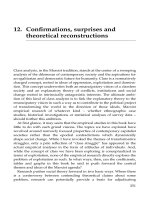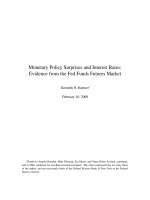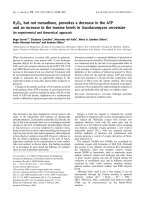Confirmations, surprises and theoretical reconstructions
Bạn đang xem bản rút gọn của tài liệu. Xem và tải ngay bản đầy đủ của tài liệu tại đây (100.79 KB, 26 trang )
12. Con®rmations, surprises and
theoretical reconstructions
Class analysis, in the Marxist tradition, stands at the center of a sweeping
analysis of the dilemmas of contemporary society and the aspirations for
an egalitarian and democratic future for humanity. Class is a normatively
charged concept, rooted in ideas of oppression, exploitation and domina-
tion. This concept underwrites both an emancipatory vision of a classless
society and an explanatory theory of con¯icts, institutions and social
change rooted in intrinsically antagonistic interests. The ultimate ambi-
tion of this kind of class analysis is to link the explanatory theory to the
emancipatory vision in such a way as to contribute to the political project
of transforming the world in the direction of those ideals. Marxist
empirical research of whatever kind ± whether ethnographic case
studies, historical investigations or statistical analyses of survey data ±
should further this ambition.
At ®rst glance, it may seem that the empirical studies in this book have
little to do with such grand visions. The topics we have explored have
revolved around narrowly focused properties of contemporary capitalist
societies rather than the epochal contradictions which dynamically
shape social change. While I have invoked the themes of transformative
struggles, only a pale re¯ection of ``class struggle'' has appeared in the
actual empirical analyses in the form of attitudes of individuals. And,
while the concept of class we have been exploring is conceptualized in
terms of exploitation, none of the empirical research directly explores the
problem of exploitation as such. In what ways, then, can the coef®cients,
tables and graphs in this book be said to push forward the central
themes and ideas of the Marxist agenda?
Research pushes social theory forward in two basic ways. Where there
is a controversy between contending theoretical claims about some
problem, research can potentially provide a basis for adjudicating
251
between the alternatives. The more focused and well de®ned is the
problem, and particularly, the more there is agreement among con-
tending views on the precise speci®cation of what needs to be explained,
the more likely it is that research can play this role. Our explorations of
alternative expectations about the transformations of the class structure
or the permeability of class boundaries are in this spirit. Where
successful, the results of research can be said to provisionally ``con®rm''
a particular set of expectations linked to a theoretical perspective, at least
in the sense of adding signi®cantly to the credibility of those expectations
even if it is never possible to absolutely prove theoretical claims. While,
at least in social science, such adjudication and con®rmation rarely bears
directly on the adequacy of broader theoretical perspectives, the cumula-
tive effect of such research can contribute to the erosion of some
perspectives and the strengthening of others.
Adjudication and con®rmation are at the core of the standard ``hypoth-
esis-testing'' strategies of contemporary sociology. Although the stan-
dard rhetoric is ``rejecting the null hypothesis'' rather than ``adjudicating
between rival hypotheses,'' nevertheless, the underlying logic of inquiry
is using evidence to add credibility to a set of expectations derived from
one theory versus alternatives. There is, however, a second modality
through which research pushes theory forward: the goal of research can
be to ®nd interesting surprises, anomalous empirical results that go
against the expectations of a theory and thus provoke rethinking. It is all
well and good to do research that con®rms what one already believes,
but the advance of knowledge depends much more on generating
observations that challenge one's existing ideas, that are counter-intui-
tive with respect to received wisdom.
Surprises of this sort may be the by-product of the adjudication
between rival hypotheses. After all, what is ``surprising'' within one
theoretical framework may be ``commonsense'' within another. The
accelerating decline of the working class is certainly a surprise within
Marxism; it is hardly surprising for post-industrial theorists. Research
which seems to con®rm the expectations of one's theoretical rivals thus
provides crucial raw material for efforts at theory reconstruction.
Empirical anomalies may also occur in research that is not explicitly
directed at adjudicating between rival hypotheses. The surprises in our
research on housework, for example, grew out of an exploration of the
implications of class analysis for gender relations rather than a direct
confrontation between alternative theories of housework. In any case, as
Burawoy (1990, 1993) has strenuously argued, empirical surprises force
Class counts252
the reconstruction of theory, and it is through such reconstruction that
social theory moves forward.
''Reconstructions'' of theory in the light of empirical surprises, of
course, may be purely defensive operations, patching up a sinking ship
that is sailing in the wrong direction. There is no guarantee that
reconstructions constitute ``progressive'' developments within a theore-
tical framework rather than degenerate branches of a research program,
to use Imre Lakatos's formulation. Nevertheless, it is through such
reconstructions that advances in theoretical knowledge are attempted.
The research in this book involves both of these modalities for linking
theory and research. Some of the research was primarily concerned with
empirically comparing the expectations of a Marxist class analysis with
expectations derived from other theoretical perspectives. Other studies
were less focused on adjudicating between well-formulated rival expec-
tations than simply exploring the implications of the Marxist approach
itself. Much of this research provides con®rmation for what I believed
before doing the research, but there were also many surprises, at least
some of which may contribute to the ongoing reconstruction of Marxist
class analysis.
It is mainly on these surprises that I want to focus in this chapter. In
what follows, for each of the major themes in the book I will ®rst present
a stylized account of what might be termed the ``conventional wisdom''
within Marxism. This is not always an easy task, for on some of the
topics we have explored Marxists have not had a great deal to say, and in
any case there are many Marxisms from which to choose the ``traditional
view.'' My characterization of the ``traditional understanding,'' therefore,
is bound to be disputed. My intention is not to give an authoritative
account of ``what Marx really said,'' but to capture a set of theoretical
intuitions shared by many ± perhaps most ± Marxists. This account of
the traditional understanding will serve as the benchmark for assessing
the ways in which the results of the various research projects provide
con®rmations of these conventional expectations or surprises. The in-
ventory of surprises, in turn, will provide the basis for exploring some of
the directions in which Marxist class analysis might be reconstructed in
light of the research.
These issues will be explored for ®ve broad themes in class analysis
which we have examined in this book: 1. the problem of conceptualizing
``locations'' within the class structure; 2. the variability and transforma-
tion of class structure of advanced capitalist societies; 3. the intersection
of the lives of individuals and class structures; 4. the effects of class on
253Con®rmations, surprises, reconstructions
class consciousness and class formation; and 5. the relationship between
class and other forms of oppression, especially gender.
12.1 Conceptualizing ``locations'' in the class structure
More than any other issue, this research has revolved around the
problem of what it means to ``locate'' a person in the class structure. If
we are to link micro- and macro-levels of class analysis by exploring the
impact of class on the lives and consciousness of individuals, some sort
of solution to this issue is essential. The image is that a structure of class
relations generates an array of ``empty places'' ®lled by individuals. To
pursue micro-level class analysis we must both ®gure out how to de®ne
these empty places and what it means for an individual to be linked to
those places.
Traditional understanding
Traditional Marxism developed a systematic conceptualization of class
structure only at the highest levels of abstraction. The ``empty places'' in
class relations were de®ned by the social property relations within
speci®c modes of production. In capitalist societies this led to the
rigorous speci®cation of two basic class locations: capitalists and workers
within capitalist relations of production. To these could be added class
locations that were rooted in various kinds of precapitalist relations of
production, especially the petty bourgeoisie within simple commodity
production, and in some times and places, various class locations within
feudal relations of production. In many concrete analyses, loose refer-
ences were also made to other class locations, especially to the new
middle class of managers and professionals, but these were not given
®rm conceptual status.
In the traditional account, individuals were linked to these empty
places through their direct relationship to the means of production:
capitalists owned the means of production and employed workers;
workers sold their labor power on a labor market and worked within
capitalist ®rms; the petty bourgeoisie were direct producers using their
own means of production. Every class location was therefore in one and
only one class. Individuals might, of course, change their class in the
course of their lives, but at any given point in time they were located
within a speci®c class.
Class counts254
Initial reconstruction
The framework elaborated in this book attempts to reconstruct the
traditional Marxist concept of class structure in two different ways.
First, the map of empty places has been transformed through the
development of the concept of contradictory locations within class rela-
tions. Instead of de®ning class locations simply at the level of abstract
modes of production, I have tried to develop a more concrete, multi-
dimensional understanding of how jobs are tied to the process of
exploitation. Speci®cally, I have argued that, in addition to the relation-
ship to the ownership of the means of production, the linkage of jobs to
the process of exploitation is shaped by their relation to domination
within production (authority) and to the control over expertise and
skills. This generates the more complex map of locations we have used
throughout the book. In this new conceptualization, the ``middle class''
is not simply a residual category of locations that do not comfortably ®t
the categories ``capitalist'' and ``worker.'' Rather, middle-class locations
in the class structure are those that are linked to the process of
exploitation and domination in contradictory ways. The ``empty places''
in the class structure, therefore, are no longer necessarily in one and
only one class.
The second way in which the traditional view of class locations has
been modi®ed is through the concept of mediated class locations. The
central point of trying to assign a class location to an individual is to
clarify the nature of the lived experiences and material interests the
individual is likely to have. Being ``in'' a class location means that
you do certain things and certain things happen to you (lived
experience) and you face certain strategic alternatives for pursuing
your material well-being (class interests). Jobs embedded within
social relations of production are one of the ways individuals are
linked to such interests and experiences, but not the only way.
Families provide another set of social relations which tie people to
the class structure. This is especially salient in families within which
different members of the family hold jobs with different class
characters. Individuals in such families have both direct and
mediated class locations, and these two links to class relations may
or may not be the same. This introduces a new level of complexity
into the micro-analysis of class which is especially relevant to the
interaction of class and gender.
255Con®rmations, surprises, reconstructions
Empirical con®rmations
Empirically ``testing'' concepts is a tricky business. Indeed, there are
some traditions of social science which regard concepts as simply
linguistic conventions, and thus there is no sense in which a particular
conceptualization can be shown to be wrong; at most a given concept can
be more or less useful than others. There is, however, an alternative view
which claims that at least some concepts should be treated as attempts at
specifying real mechanisms that exist in the world independently of our
theories. For such ``realist concepts,'' a de®nition can be incorrect in the
sense that it misspeci®es some crucial feature of the relevant causal
properties (see Wright 1985: 1±37).
The concept of class being proposed in this book is meant to be a
realist concept, not simply an arbitrary convention. The appropriate way
of evaluating the concept, therefore, is to examine a variety of effects that
the hypothesized class-de®ning mechanisms are supposed to generate. If
a given conceptualization is correct, then these effects should follow
certain expected patterns. Anomalies with respect to these expectations,
of course, need not invalidate the concept, since failures of prediction of
this sort can be due to the presence of all sorts of confounding mechan-
isms (including the special kind of confounding mechanism we call
``measurement problems''). Nevertheless, as in more straightforward
hypothesis testing, such surprises pose challenges which potentially
provoke reconstructions.
In one way or another, nearly all of the results of this book bear on the
problem of evaluating the adequacy of the proposed conceptualization
of class structure, even though little of the research is directly geared
towards ``testing'' this conceptualization against its rivals. Still, a few of
the results have a particularly clear relation to the theoretical logic which
underlies the conceptualization of class in this book.
First, in the analysis of class consciousness, the variation across class
locations in individual attitudes towards class issues broadly follows the
predictions derived from the three-dimensional class structure matrix.
Particularly in Sweden and the United States, the extent to which
individuals were likely to hold pro-capitalist or pro-working class
attitudes varied monotonically across the three dimensions of the matrix.
This does not, of course, decisively prove that this is the appropriate way
of specifying the concept of class location within a Marxist framework,
but it lends credibility to the approach.
The second speci®c way the results of this research support the
Class counts256
proposed reconceptualization of class is more complex. In the various
analyses of the permeability of class boundaries, it was demonstrated
that the probabilities of permeability events (mobility, friendships, cross-
class marriages) occurring between speci®c class locations were not
simply additive effects of permeability across the three class boundaries
we studied ± the property boundary, the authority boundary and the
skill boundary. For example, the probability of a friendship between a
person in a working-class location and one in a capitalist location was
not simply the sum of the probabilities of a friendship across the
property boundary and across the authority boundary. If the effects of
these three boundaries had been strictly additive, then this would have
suggested that aggregating the dimensions into a ``class structure'' was
simply a conceptual convenience. Nothing would be lost by disaggre-
gating the class structure into these more ``primitive'' dimensions and
treating them as separate, autonomous attributes of jobs. The consistent
interactions among these dimensions in the patterns of class permeability
support the claim that these three dimensions should be considered
dimensions of a conceptual gestalt ± ``class structure'' ± rather than
simply separate attributes of jobs.
Third, the credibility of the concept of mediated class locations is
demonstrated in the analysis of the class identity of married women in
two-earner households. At least in Sweden, the class identity of such
women was shaped both by their own job±class and by the class of their
husband. While there are complications in this analysis which we will
review in the discussion of class consciousness below, these results
generally support the idea that individuals' locations in a class structure
should be conceptualized in terms of the multiple ways in which their
lives are linked to class relations.
Surprises
Most of the empirical results in this book are consistent with the
proposed reconceptualization of class structure. There are, however, two
speci®c sets of results that are somewhat anomalous and thus raise
questions about the concept of contradictory class locations. Both of
these involve the relationship between the authority and expertise
dimensions of the class structure matrix, one in the analysis of perme-
ability of class boundaries, the other in the investigation of class
consciousness. We will discuss these results in more detail later when we
examine the general results for class permeability and for class con-
257Con®rmations, surprises, reconstructions
sciousness. Here I will only focus on how these results bear on the
conceptualization of contradictory class locations.
First, in the analyses of permeability of class boundaries, for each of
the kinds of permeability we studied the authority boundary was always
much more permeable than the expertise boundary (and in some
analyses not signi®cantly impermeable in absolute terms), yet, within a
Marxist framework, authority is more intimately linked than is skill or
expertise to the fundamental class cleavage of capitalism, the capital±
labor relation. This relatively high permeability of the authority
boundary compared to the expertise boundary is thus in tension with
my reconstructed Marxist class concept in which authority constitutes a
dimension of the class structure among employees rather than simply an
aspect of ``strati®cation'' or even merely ``role differentiation.''
Second, in Japan the extremely muted ideological differences across
levels of managerial authority compared to a rather sharp ideological
cleavage between experts and nonexperts at every level of the authority
hierarchy also run against the implications of the contradictory class
location concept. Since the items we use as indicators of class conscious-
ness center around capital±labor con¯ict, if it were the case that manage-
rial authority de®nes the basis for a contradictory location linked to the
capitalist class, then it is surprising that ideological differences along this
dimension are so muted in a thoroughly capitalist society like Japan, and
it is especially surprising that the expertise cleavage is so much more
striking than the authority cleavage.
Further possible reconstructions?
Both of these anomalous results may simply be the result of measure-
ment problems. The Japanese results are obviously vulnerable to all sorts
of measurement errors on the attitude questions. But measurement
issues may equally undermine the permeability results. Even though we
tried to restrict the permeability of the managerial boundary to events
that linked proper managers (not merely supervisors) to employees
outside of the authority hierarchy, in several of the analyses it was
impossible to rigorously distinguish managers and supervisors. Further-
more, even the ``manager'' category includes people near the bottom of
authority structures. The fact that throughout the book we have amalga-
mated managers in small businesses with managers in multinational
corporations may also confound the analyses. It is one thing for the
manager of a locally owned retail store or a McDonald's franchise to be
Class counts258
good friends with workers and to have come from a working-class
family, and another thing for a manager in the headquarters of IBM (let
alone an executive) to have such ties. It may well be the case, therefore,
that these results would be quite different if we restricted managers to
people with decisive power over broad organizational resources and
policymaking and distinguished large-scale capitalist production from
small business.
However, if these anomalous results turn out to be robust, they may
indicate that the concept of ``contradictory class locations'' does indeed
meld a relational concept of class rooted in capitalist property relations
with dimensions of gradational strati®cation. This is most obvious for
the skill-expertise dimension, which seems to have a natural grada-
tional logic of having more or less of something. Authority is inher-
ently a relational property of jobs; yet its place within class analysis
might better be understood in terms of strata within classes rather
than a distinctive kind of class location. This line of reasoning might
suggest a fairly radical conceptual shift away from the idea of contra-
dictory locations within class relations: authority and expertise would
be treated as the bases for gradational strata within the class of
employees de®ned by capitalist relations of production. Such a class
analysis could still claim to be Marxist insofar as the class concept
itself remained deeply linked to the problem of exploitation and
capitalist property relations, but it would no longer attempt to specify
differentiated class locations at concrete, micro-levels of analysis
among employees. If this conceptual move were embraced, then the
distinctively Marxist class concept would primarily inform analyses at
the more abstract levels of class analysis, whereas something much
more like a gradational concept of social strati®cation would inform
concrete levels of analysis.
I do not believe that these particular results for managers are so
compelling as to call for this kind of conceptual transformation. For most
of the analyses in this book, the divisions among employees which we
have mapped along the authority and expertise dimensions appear to
have class-like effects, and the concept of contradictory locations within
class relations does a good job of providing an explanatory framework
for understanding the results. Taken as a whole, the results of the studies
in this book af®rm the fruitfulness of the concept of contradictory class
locations. Thus, while the conceptual framework does not achieve the
level of comprehensive coherence, either theoretically or empirically,
which I had hoped for when I ®rst began working on the problem of the
259Con®rmations, surprises, reconstructions
middle class, the anomalies are not so pressing as to provoke a new
conceptual metamorphosis.
12.2 Class structure and its variations in advanced capitalist societies
Traditional understanding
The traditional Marxist view of the variations across time and place in
the class structure of capitalist societies revolves around three broad
propositions:
1 The distribution of the population into different classes within capitalism
should depend largely upon the level of development of the ``forces of
production'' (technology and technical knowledge). This should be particu-
larly true for the distribution of class locations within capitalist
production itself. Since our sample is of countries which are all at
roughly the same level of economic development, it would be
expected that their class distributions should not differ greatly.
2 The broad tendency of change over time in class distributions within capitalist
societies is towards an expansion of the working class. There are two
principle reasons for this expectation: ®rst, the petty bourgeoisie and
small employer class locations are eroded by competition from larger
capitalist ®rms, thus expanding the proportion of the labor force
employed as wage-earners; and, second, rationalization and technical
change within production, designed to maximize capitalist pro®ts,
tends to generate a ``degradation of labor'' ± the reduction in the skills,
autonomy and power of employees ± which results in a relative
expansion of proletarianized labor among wage-earners.
3 As a result of these two propositions, the expectation is that the working class
should be the largest class within developed capitalist societies. The image of
developed capitalist societies as becoming largely ``middle-class socie-
ties'' would be rejected by most Marxists, regardless of the speci®c
ways in which they elaborate the concept of class.
Con®rmations
Some aspects of these traditional understandings are supported by the
data in Part I of this book. In all six of the capitalist societies we
examined, the working class remains the single largest location within
the class structure, and, when unskilled supervisors and skilled workers
Class counts260









